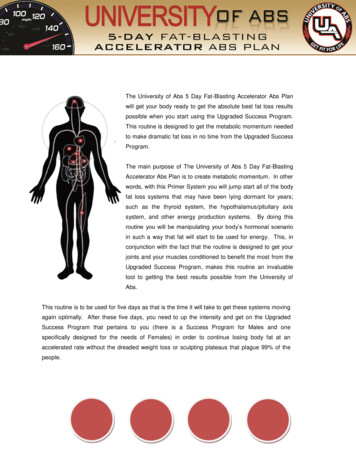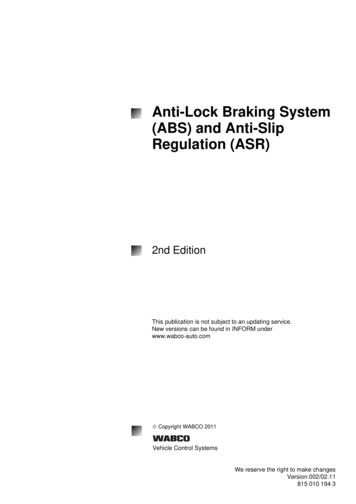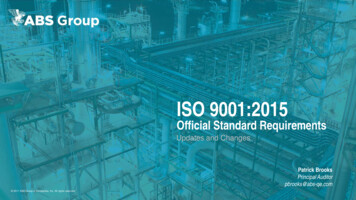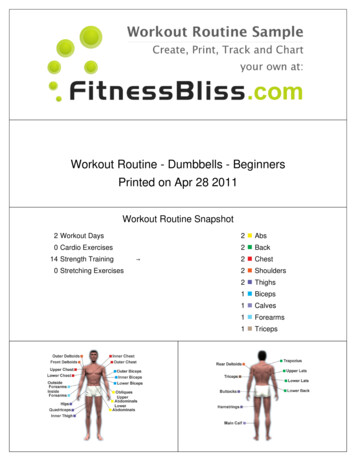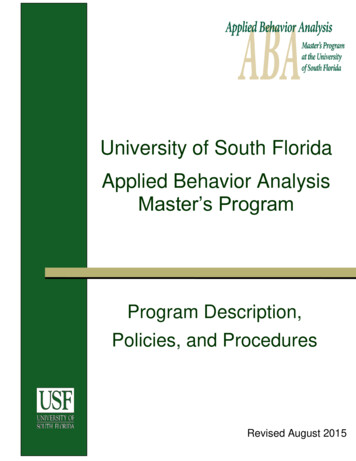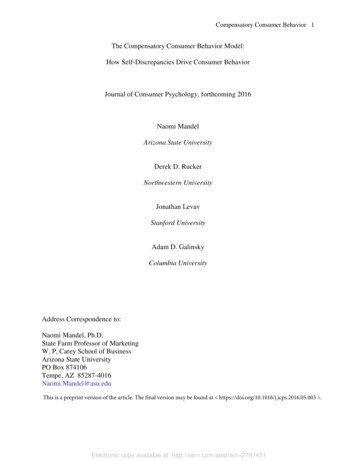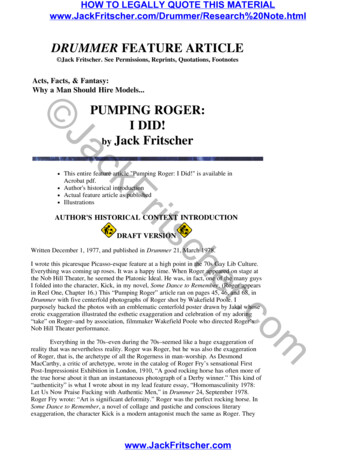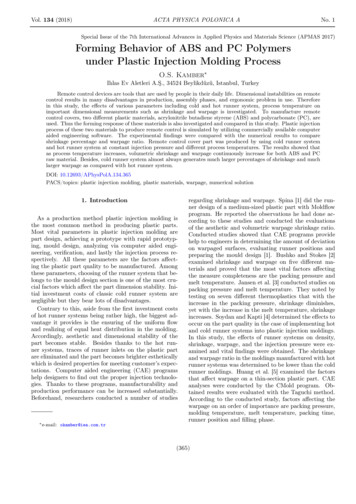
Transcription
Vol. 134 (2018)ACTA PHYSICA POLONICA ANo. 1Special Issue of the 7th International Advances in Applied Physics and Materials Science (APMAS 2017)Forming Behavior of ABS and PC Polymersunder Plastic Injection Molding ProcessO.S. Kamber Ihlas Ev Aletleri A.Ş., 34524 Beylikdüzü, Istanbul, TurkeyRemote control devices are tools that are used by people in their daily life. Dimensional instabilities on remotecontrol results in many disadvantages in production, assembly phases, and ergonomic problem in use. Thereforein this study, the effects of various parameters including cold and hot runner system, process temperature onimportant dimensional measurements such as shrinkage and warpage is investigated. To manufacture remotecontrol covers, two different plastic materials, acrylonitrile butadiene styrene (ABS) and polycarbonate (PC), areused. Thus the forming response of these materials is also investigated and compared in this study. Plastic injectionprocess of these two materials to produce remote control is simulated by utilizing commercially available computeraided engineering software. The experimental findings were compared with the numerical results to compareshrinkage percentage and warpage ratio. Remote control cover part was produced by using cold runner systemand hot runner system at constant injection pressure and different process temperatures. The results showed thatas process temperature increases, volumetric shrinkage and warpage continuously increase for both ABS and PCraw material. Besides, cold runner system almost always generates much larger percentages of shrinkage and muchlarger warpage as compared with hot runner system.DOI: 10.12693/APhysPolA.134.365PACS/topics: plastic injection molding, plastic materials, warpage, numerical solution1. IntroductionAs a production method plastic injection molding isthe most common method in producing plastic parts.Most vital parameters in plastic injection molding arepart design, achieving a prototype with rapid prototyping, mould design, analyzing via computer aided engineering, verification, and lastly the injection process respectively. All these parameters are the factors affecting the plastic part quality to be manufactured. Amongthese parameters, choosing of the runner system that belongs to the mould design section is one of the most crucial factors which affect the part dimension stability. Initial investment costs of classic cold runner system arenegligible but they bear lots of disadvantages.Contrary to this, aside from the first investment costsof hot runner systems being rather high, the biggest advantage it provides is the ensuring of the uniform flowand realizing of equal heat distribution in the molding.Accordingly, aesthetic and dimensional stability of thepart becomes stable. Besides thanks to the hot runner systems, traces of runner inlets on the plastic partare eliminated and the part becomes brighter estheticallywhich is desired properties for meeting customer’s expectations. Computer aided engineering (CAE) programshelp designers to find out the proper injection technologies. Thanks to these programs, manufacturability andproduction performance can be increased substantially.Beforehand, researchers conducted a number of studies e-mail:regarding shrinkage and warpage. Spina [1] did the runner design of a medium-sized plastic part with Moldflowprogram. He reported the observations he had done according to these studies and conducted the evaluationsof the aesthetic and volumetric warpage shrinkage ratio.Conducted studies showed that CAE programs providehelp to engineers in determining the amount of deviationon warpaged surfaces, evaluating runner positions andpreparing the mould design [1]. Bushko and Stokes [2]examined shrinkage and warpage on five different materials and proved that the most vital factors affectingthe measure completeness are the packing pressure andmelt temperature. Jansen et al. [3] conducted studies onpacking pressure and melt temperature. They noted bytesting on seven different thermoplastics that with theincrease in the packing pressure, shrinkage diminishes,yet with the increase in the melt temperature, shrinkageincreases. Soydan and Kapti [4] determined the effects tooccur on the part quality in the case of implementing hotand cold runner systems into plastic injection moldings.In this study, the effects of runner systems on density,shrinkage, warpage, and the injection pressure were examined and vital findings were obtained. The shrinkageand warpage ratio in the moldings manufactured with hotrunner systems was determined to be lower than the coldrunner moldings. Huang et al. [5] examined the factorsthat affect warpage on a thin-section plastic part. CAEanalyses were conducted by the CMold program. Obtained results were evaluated with the Taguchi method.According to the conducted study, factors affecting thewarpage on an order of importance are packing pressure,molding temperature, melt temperature, packing time,runner position and filling phase.okamber@iea.com.tr(365)
366O.S. KamberHassan et al. [6] examined the effect of the runner inlet point on shrinkage, warpage and residual stress in thechilling of the polymer material. Kovacs and Siklo [7]developed a new measuring method by making a plastic sample part molding in V type different from thecurrently undergoing studies. Parameters which are approached in this paper are molding temperature, molding temperature difference, packing pressure, and glassfiber reinforcement. These parameters were examinedby trying three different runner inlets and as a result itwas determined that when glass fiber material is usedfor production, it has almost no effect on the warpageof the packing pressure. Erzurumlu and Özçelik [8] usedthe Taguchi method. They conducted investigations ofwarpage and sink in plastic parts on different rib sectional and rib plane angles. Transaction parameters thatwere used here were examined by implementing moldingtemperature, packing pressure, rib sectional types andrib plane angles. Polymeric tools used in the experiments are PC/ABS, POM and PA 66. Using orthogonalTaguchi analysis, variance analysis (ANOVA), optimumvalues of the process parameters were investigated forwarpage and sink. Liao et al. [9] investigated the effectsof process parameters between each other for thin cellphone open cover. L 27 experimental Taguchi methodswere used. Poly Cad and Poly Works programs wereused to define shrinkage and warpage. Optimum processconditions are different for shrinkage and warpage. Inthis study, optimum process conditions were found experimentally to decrease shrinkage and warpage with theTaguchi method. Molding temperature, melt temperature, packing pressure and injection speed; these weretaken as the Taguchi factors.Pomerleau and Sanschagrin [10], by putting orthogonal marks on the molding in a plane, compared the regional shrinkage values with measures in the plane onpart’s surface. It was used in finding the measures thatare parallel and perpendicular to the profilograph flow.A sensitiveness analysis was used in finding the valuesthat cause shrinkage. The effect of the packing pressureand injection speed on shrinkage was investigated experimentally. Liad and Hsieh [11] reported the estimationof shrinkage and warpage in the parts those of thin wallthickness by using artificial neural networks. Kurt etal. [12] investigated influence of molding conditions onthe shrinkage and roundness of injection molded parts.In this study, the effects of molding parameters including packing pressure, melt temperature, and cooling timeon shrinkage and roundness have been investigated experimentally. Also, the relationship among initial molding parameters, the cavity pressure, and mold temperature was investigated. This study illustrated that packing pressure and melt temperature are dominant factorswhich determine the quality of parts. Liu et al. [13] investigated the effects of process parameters such as melttemperature, mold temperature, and melt filling rate onthe surface gloss of plastic parts produced with water assisted injection molding. Pigmented polypropylene wasused as the polymer in this study. It was observed thatincrease of melt temperature decreases the surface glossof material. Also, crystallinity and molecular chain orientation induced by shear stress in the molded parts mayaffect the surface gloss. Oliveira et al. [14] investigatedthe effect of injection parameters on the surface gloss ofthe ABS plastic parts. It was observed that if the mouldcavity surface is very smooth, the surface gloss of themolded parts increase with the mold temperature, melttemperature, and the holding pressure increase. The increase of these parameters causes opposite effect with theother surfaces.As comprehensive literature review presented aboveshows that no study shows the effects of hot and cold runner system on dimensional accuracy including warpageand shrinkage of molded parts made of ABS and PC.Because of these important points, this study providesexperimental data that can be very useful for industryand academic studies. Bedsides, numerical simulation ofmolding process of these two materials is presented tocompare with experimental data.2. Experimental procedureThe remote control cover is a complex part in whichwall thickness is not uniform and which contains holes,ribs, hard-edge forms with radius. Main measures of thepart are 125.23 mm 28.78 mm 13.7 mm and the averagewall thickness is 2.4 mm. At some places, wall thicknesseven reaches 5.6 mm. The 2D and 3D drawing of thepart is shown in Fig. 1.Fig. 1.(a) 3D and (b) 2D drawing of the part.Mould was designed with SolidWorks Premium Program and produced such that both cold runner and hotrunner is arranged in the same runner point in the samemould. To ensure measure stability and to minimizewarpage, male and female parts and cores of mold wereexposed to the cooling process in the same temperatures.Figure 2 shows the 3D drawing of the designed mold andits photographs.In this study ABS and PC polymers are used as rawmaterials. ABS HI-121 is an amorphous polymer produced by LG Chem and PC1803R is an amorphous polymer produced by Sabic Innovative Plastics. The processtemperature range is 210–240 C for ABS and 170–260 Cfor PC. The detailed specification of these polymers isshown in Table I.
Forming Behavior of ABS and PC Polymers under Plastic Injection Molding Process367of the produced parts are shown in Fig. 3.Fig. 3. The photographs of produced parts made of (a)ABS, (b) PC materials.3. Experimental resultsShrinkage of produced parts is measured consideringlength, width and height of components. The measurement approach is demonstrated in Fig. 4. These three geometrical measurements are of more or less defined wholeparts dimensional accuracy. Therefore, these three pointsare taken to understand the input variables and dimensional accuracy criteria’s relation.Fig. 2. (a) 3D drawing of designed mold, (b) photograph of produced molds.Specifications of the molding materialsTABLE IMaterialcommercial nameresin typedensitymelt flow indexABSPCABS HI-121PC1803Ramorphous1.04 g/cm31.20 g/cm37 g/l0 min18 g/l0 min(230 C/3.8 kg) (300 C/1.2 kg)process temperature200–240 C280–300 Ctensile strength45.1 MPa63 MPaflexural modulus2450 MPa2300 MPaThe brand name and model of the injection moldingmachine are Haitian and HTFX150. It has 150 tonnesclamping force and 230 g shot capacity. The remote control devices cover parts are produced at constant injection pressure in different melt temperatures with ABSand PC polymers and both hot runner system and coldrunner system.ABS parts were produced with 5 different temperaturein the 200–240 C temperature range that manufacturerdefined. PC parts were produced with 5 different temperature in the 280–300 C temperature range that manufacturer defined. The injection pressure was 80 MPa, packing pressure was 40 MPa, mold temperature for ABS rowmaterial was 40 C, for PC material it was 80 C, cycletime for ABS material was 40 s, it was 50 s for PC material. Injection velocity was 0.012 m/s for ABS materialand it was 0.02 m/s for PC material. The photographsFig. 4.The length, width and height of the part.Figure 5 depicts shrinkage percentage changes withchanging process temperature at 80 MPa pressure whenABS is used as plastic injection molding material. Inthis measurement not only one side, but also three different point is considered, are length, width and height forcold and hot runner. Shrinkage increases when processtemperature increases in all measurements. Cold runnerproduces more shrinkage than hot runner. The reason ofthis result is that cold runner generates more cavities andunfilled area within part and after plastic injection molding is completed, then shrinkage becomes more. But hotrunner produces more filled parts and shrinkage is less.Maximum shrinkage is measured at height of parts in hotand cold runner. Therefore, it can be possible to say thatheight is more sensitive to temperature change than theother dimensions of produced components.Figure 6 depicts shrinkage percentage changes withchanging process temperature at 80 MPa pressure whenPC is used as plastic injection molding material with hotrunner and cold runner. Shrinkage increases when process temperature increases in all measurements. As same
368O.S. Kambermethod as reference, the effect of hot runner and coldrunner is investigated. Warpage is calculated with H hvalues. H represents the height of warped point according to surface plate and h represents the height of thepart in the design.Fig. 7.Fig. 5. The length, width shrinkage rates of the partat 80 MPa injection pressure for ABS.with ABS material, cold runner produces more shrinkagethan hot runner for all dimensional measurement. It wasclear that similar mechanism occur with ABS materialin PC material. Cold runner produces more cavities andunfilled area within part and after plastic injection molding is completed, then shrinkage becomes more. Yet hotrunner produces more completed parts during the forming process and shrinkage is less on the all measured dimensions. Maximum shrinkage is measured at height ofpart and then width in cold runner and same thing occurwith hot runner process. Increased percentage of shrinkage with increasing process temperature from 280 C to300 C is around fifty percent that is much more than theeffect of runner design.Demonstration of warpage measurement.Figure 8 depicts warpage measurement with changingprocess temperature at constant 80 MPa pressure whenABS material is used as plastic injection molding material with hot runner and cold runner. Warpage increaseswhen process temperature increases in both runner design. Comparing to hot runner, cold runner producesmore warpage. Considering the length of warpage, coldrunner produces more cavities and unfilled area withinpart and after plastic injection molding is completed,and these unfilled and nonhomogeneous structure causewarpage in produced plastic injected mold parts. However, hot runner produce more filled parts and more homogeneous structure and warpage is less than cold runner. The raise rate of warpage with increase process temperature is around 40 percent when process temperatureincrease from 200 to 240 C.Fig. 8. Warpage percent of ABS made componentbased on x axis.Fig. 6. The length, width, and height shrinkage ratesof the part at 80 MPa injection pressure for PC material.These results depict that in both plastic material, inother words ABS and PC, molding temperature showthe same effects and hot runner produces better quality and accuracy. But more than raw material and various dimension, process temperature is effective to determine the dimensional accuracy of produced plasticparts. In plastic injection molding, in addition to shrinkage, warpage is also measured and needed because justshrinkage is not enough to reach decision that producedparts are of very good considering dimensional accuracy.Figure 7 depicted the measurement methods of warpagefor this produced material. By taking this measurementFigure 9 depicts warpage measurement with changingprocess temperature at constant 80 MPa pressure whenPC material is used as plastic injection molding material with hot runner and cold runner. Similar to theABS material, warpage increases when process temperature increases in hot runner used and cold runner usedprocesses. Cold runner produces more warpage than hotrunner. When the length of warpage is taken, cold runnerproduces more cavities and unfilled area within part andafter plastic injection molding is completed, and theseunfilled and inhomogeneous structures cause warpage inproduced plastic injected mold parts. The mechanismdoes not change when material is changed from ABSto PC. Therefore, smaller process temperature and hotrunner should be used to reduce warpage of components
Forming Behavior of ABS and PC Polymers under Plastic Injection Molding Processmade of both ABS and PC material.3692.23 percent volumetric shrinkage, but when hot runnerused, volumetric shrinkage percentage is around 1.56.Therefore, simulation shows that cold runner producesmore shrinkage when it is compared with hot runner.This shows good similarity and validation of experimental data presented above. Table II also shows simulationresult of PC polymer raw material. Again cold runnerproduces 1.38 volumetric shrinkage but hot runner produces 0.95 volumetric shrinkage. Simulation is also validated experimental data for PC material.TABLE IIMold flow analysis of average volumetric shrinkagerates for ABS and PC at 80 MPaFig. 9. Warpage percent of PC made component basedon x axis.4. Numerical validationFor computer aided engineering software, the moldflow software was used. It was necessary to predict theresponse of ABS and PC material to compare with theexperimental data. Figure 10 shows mold flow analysis for predicting volumetric shrinkage for ABS materialwith hot and cold runner. Besides, Fig. 11 depicts sameanalysis for PC polymer raw material. There is big difference in between hot runner and cold runner results forshrinkage prediction.CRSHRSShrinkage rates [%]ABSPC2.231.381.560.95Plastic injection process for these two materials forpredicting warpage is also simulated using commerciallyavailable mold flow software. Figure 12 depicts the moldflow analysis of x axis warpage of parts made of ABSpolymer material, (a) with hot runner, (b) with cold runner system. Figure 13 depicts the predicted warpage forthe same condition for PC polymer material. Simulatedall conditions show some difference. The obtained prediction is depicted in Table III. When cold runner design isused for simulation of plastic injection molding processfor ABS material, average warpage is 0.28. When hotrunner design is used, average warpage is 0.24. Therefore this prediction shows similar results with experimental data depicted in previous section. Simulation for PCpolymer materials also depicts similar response. Withhot runner warpage is much less for PC polymer material than when cold runner is used.Fig. 10. Mold flow analysis of volumetric shrinkage forABS material: (a) with hot runner, (b) with cold runnersystem.Fig. 12. Mold flow analysis of x axis warpage of partsmade of ABS polymer material: (a) with hot runner,(b) with cold runner system.Fig. 11.As in Fig. 10, but for PC material.The prediction result is depicted in Table II for bothcold runner and hot runner design used molding processsimulation by using mold flow. When cold runner used,ABS polymer material made component produces aroundSimulation depicts that narrowed cross-section on theplastic components causes warpage because it is not filledwell. Also the area warpage occurrence is far away fromthe runner. The area close to runner is more homogeneous and not big warpage is observed. Thus, numericalsimulation for both shrinkage and warpage shows similarresults with experimentation. Therefore numerical sim-
370O.S. Kamberat high dimension of produced part, and the least dimensional error occurs in length of produced part. Mold flowanalysis study also shows similar results with experimental data and validates the experimental data. To reduceshrinkage and warpage, hot runner design can be used.Besides, to reduce error, PC material can be used so thatdimensional error can become minimal.Fig. 13.As in Fig. 12, but for PC polymer material.ReferencesTABLE IIIMold flow analysis of predicted x axis warpageoccurring after filling process for ABS and PC at80 MPaCRSHRSAverage warpage [mm]ABSPC0.280.080.240.06[1][2][3][4][5]ulation can be used to optimize process and so reduceboth warpage and shrinkage.5. ConclusionsThis study investigated the forming response of twopolymer materials, ABS and PC under plastic injectionmolding process for remote control covers. The inputparameters were runner design, in other words hot andcold runner and process temperature. The effect of theseparameters on warpage and shrinkage is investigatedduring producing remote control cover parts. For remotecontrol cover producing, mold is design and fabricated.Experimental study depicts that during forming processof both ABS and PC polymer, processing temperatureis important. High processing temperature causes bigvolumetric shrinkage and big warpage. ABS materialgenerates bigger volumetric shrinkage and warpage whenit is compared with PC material. Also cold runner causesmore volumetric shrinkage and big warpage when it iscompared to hot runner. The maximum shrinkage occurs[6][7][8][9][10][11][12][13][14]R. Spina, J. Mater. Process. Tech. 155-156, 1497(2004).W.C. Bushko, V.K. Stokes, Polym. Eng. Sci. 36, 322(1996).K.M.B. Jansen, D.J. Van Dijk, M.H. Husselman,Polym. Eng. Sci. 38, 838 (1998).A. Demirer, Y. Soydan, A.O. Kapti, Mater. Des. 28,1467 (2007).M.C. Huang, C.C. Tai, J. Mater. Process. Tech. 110,1 (2001).H. Hassan, N. Regnier, G. Defaye, Int. J. Heat FluidFlow 30, 1218 (2009).J.G. Kovacs, B. Siklo, Polym. Test. 30, 543 (2011).T. Erzurumlu, B.Özçelik, Mater. Des. 27, 853 (2006).S.J. Liao, D.Y. Chang, H.J. Chen, L.S. Tsou, J.R. Ho,H.T. Yau, W.H. Hsieh, Polym. Eng. Sci. 44, 917(2004).J. Pomerleau, B. Sanschagrin, Polym. Eng. Sci. 46,1275 (2006).S.J. Liad, W.H. Hsieh, Polym. Eng. Sci. 44, 2029(2004).M. Kurt, O.S. Kamber, Y. Kaynak, G. Atakok,O. Girit, Mater. Des. 30, 3217 (2009).S.J. Liu, Y.C. Wu, W.K. Chen, Plast. Rubber Compos. Process. Appl. 35, 29 (2006).M.J. Oliveira,A.M. Brito,M.C. Costa,Polym. Eng. Sci. 46, 1394 (2006).
Forming Behavior of ABS and PC Polymers under Plastic Injection Molding Process 367 Fig.2. (a) 3D
